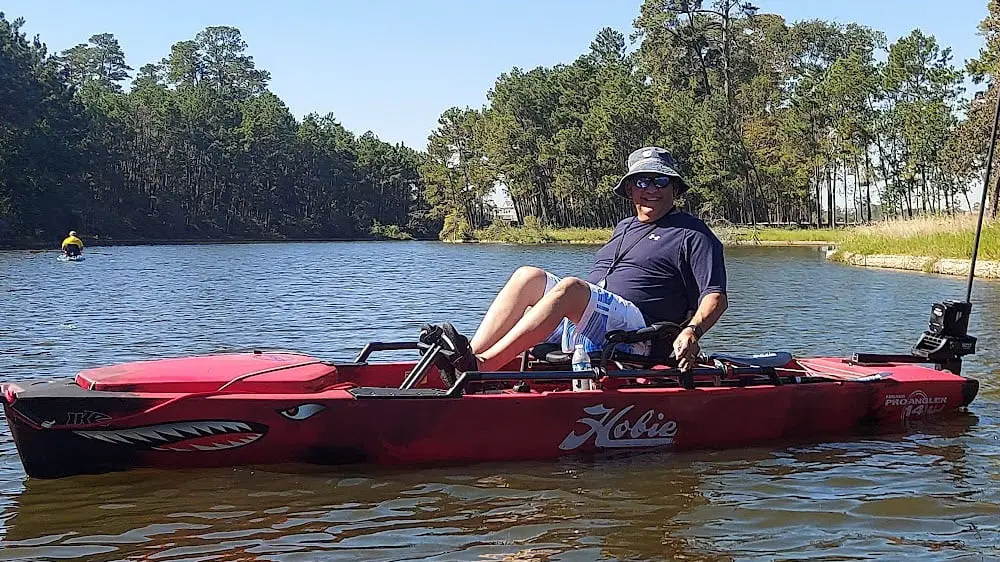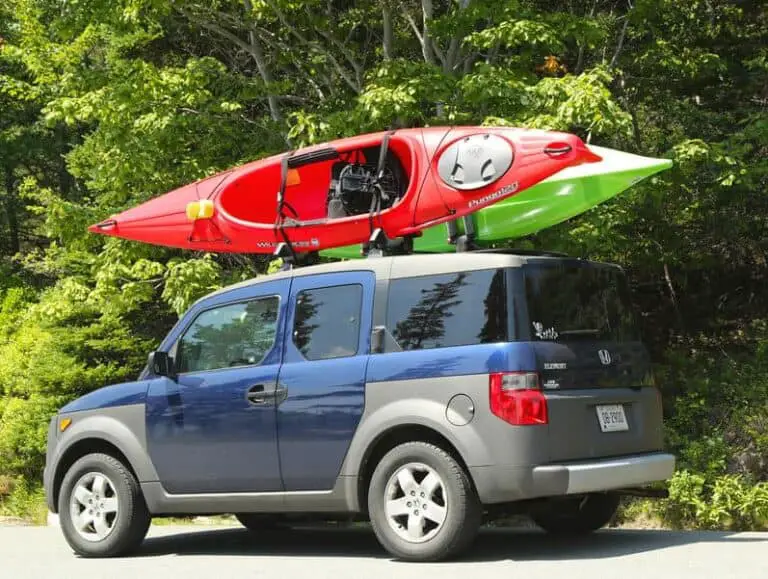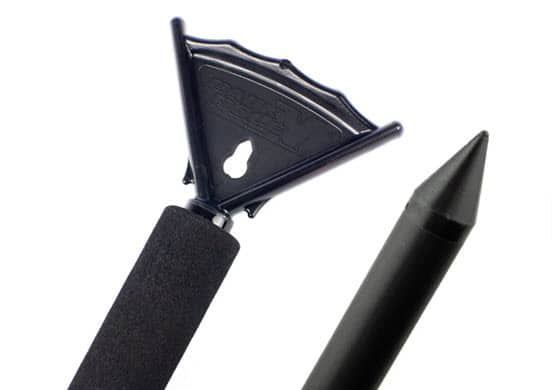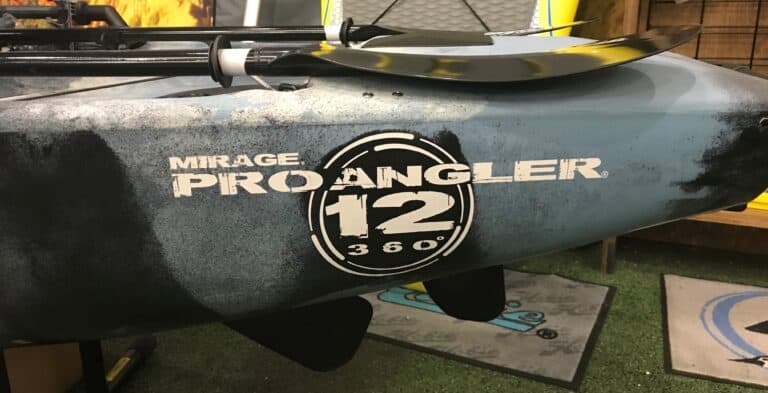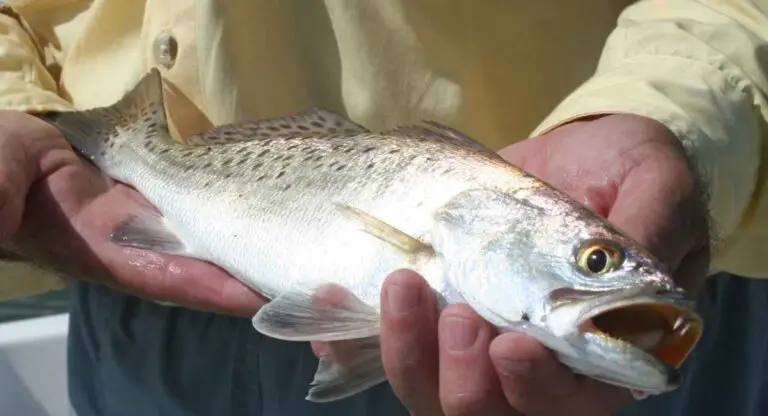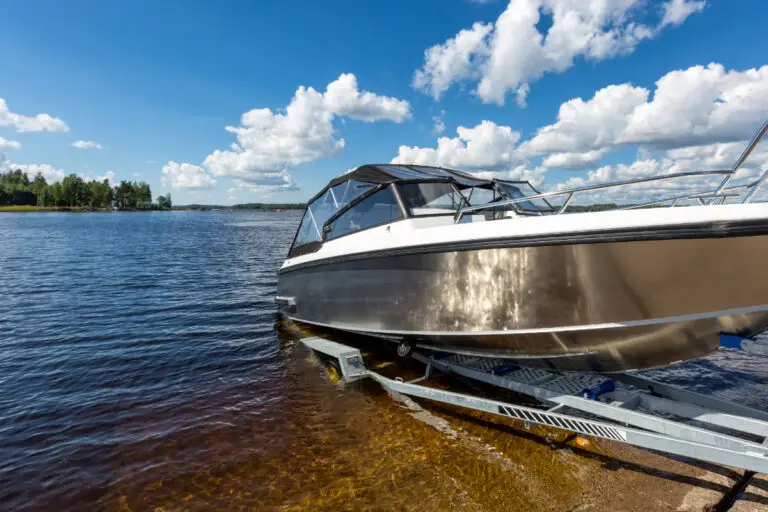Is A Fishing Kayak With Pedals Worth The Price? (5 Reasons Explained)
If you’re considering getting into kayak fishing, you may wonder if a pedal-powered kayak is worth the extra money. In this blog post, we’ll look at the pros and cons of pedal-powered kayaks to help you make the best decision for your needs.
There are several reasons why a regular paddle kayak might not work for you:
- you have physical limitations that keep you from paddling a kayak
- fishing with a paddle across your lap makes it difficult to fish
- you’re returning from fishing trips with fatigue or pain in your back and shoulders
- moving between fishing spots takes too long, limiting the time you can spend on the water
- having to keep your knees straight while sitting is uncomfortable and limiting.
Pedal-drive kayaks are a good option for people who have these issues. There are other benefits too.
Pedal kayaks offer a higher speed with hands-free kayak fishing and a sit-on-top fishing platform which is perfect for sight casting. Most come with a rudder system or skeg for better tracking.
Anglers also love horizontal rod storage, built-in rod holders, captain-style seats, and plenty of room for storage hatches for gear.
If you enjoy kayak fishing, should you buy a pedal kayak? These kayaks allow us to cast and reel while moving and Sight fish more efficiently. Also, they’re easier on the back and cover the ground faster. Standard fishing kayaks can cost between $800-$1400, whereas pedal kayaks run about $1650 – $3449. So, purchasing a pedal drive fishing yak is worth the price when all features are considered.
By exploring the features and benefits below, you’ll see how this product will help your navigation problems while also being an excellent value for fishing.
In this article, you will:
- learn what a pedal drive system is
- look over a feature and capability comparison between pedal and paddle kayaks
- learn about the different pedal drive systems
- understand the advantages of each drive type
- check out pedal drive kayak manufacturer resource links to get more information
- consider the cost comparisons between a pedal system versus a standard kayak
- go over the value comparison to decide if a pedal kayak is right for you and your budget
Ok, let’s get started!
What Is A Pedal Drive System For A Kayak?
First, let’s look into what these pedal propulsion drives are and how they work.
A pedal drive system on a kayak usually comes with two rotational pedals and a shaft that submerges into the water below with a prop that spins as you pedal.

Other times they come with a pair of elliptical-style pedals you push with your feet with fins underneath the water that stroke back and forth like the Hobie kayak pedal drive (the Miragedrive 180 or the new MirageDrive 360) and the Pelican Catch 130 Hydryve fishing kayak.
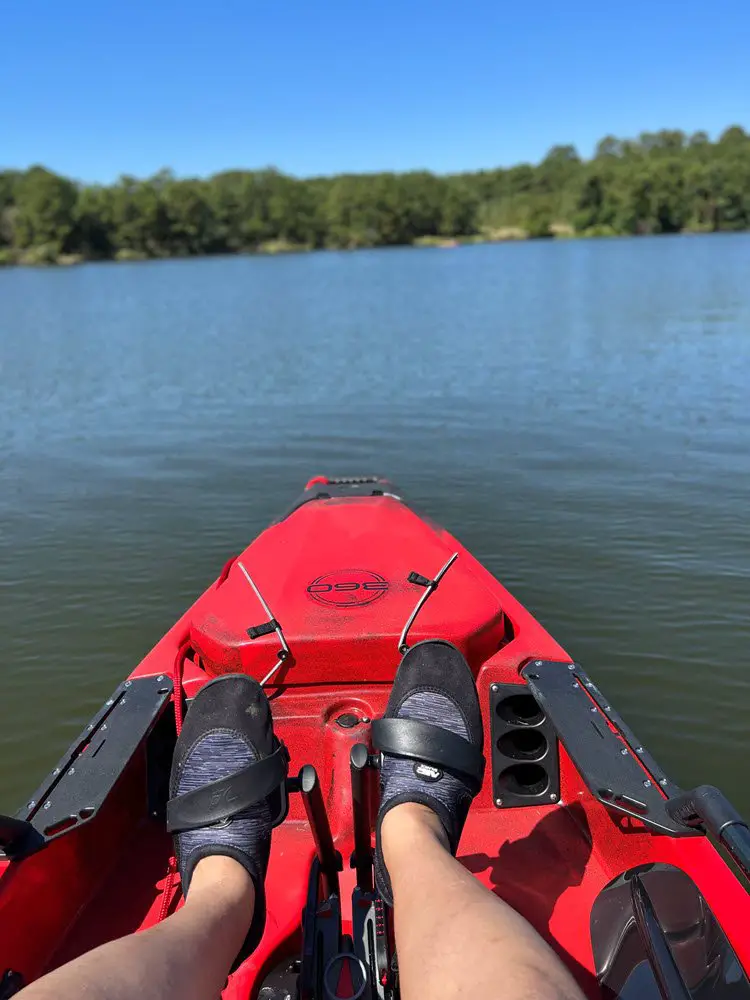
But now that we know what they are, how can they improve kayak fishing? We find that out next.
What Is The Difference Between Pedal Kayaks Vs Paddle?
Paddling your kayak is a great exercise and provides close interaction with the feel of the water, the currents, and the direction.
Pluses include a kayak at a cheaper cost, good upper body aerobic exercise, and better maneuverability in low water areas and heavy weeds. The cons are overtaxing your neck, shoulders, and back and awkwardness during fishing and casting.
Most people don’t tire as quickly with leg action and can travel longer. Additionally, pedaling your kayak with fully rotational pedals provides smoother, faster movement through the water. Moving forward or backward with just the power of your legs appeals to others who plan on hands-free fishing. This is perfect for the kayak angler.
For recreation, it’s a toss-up on which option is best. Both provide good cardiovascular exercise and have navigational advantages.
Everyone has preferences and priorities. Some like recreation, exercise, and sport. Some people like to kayak to swim across the water as quietly and gently as possible.
Want to know more about fishing kayaks? Read this post on What is a fishing kayak and its best features?
What Are The Advantages Of Pedal Drive Systems While Fishing?
Pedal kayaks are great for fishing because you can travel around while you fish.
- You don’t need a paddle on your lap
- You can have a lot of workspace in the cockpit deck
- You can change your tackle, unhook and measure fish, and put them in a fish bag
- Standing while casting or fighting a big Bull Red is effortless from the platform
The downside is that you have to deal with a pedal drive at your feet, and you might have to take it off when you go into shallow water. The pedal drive on the deck can be a challenge while standing, especially if you’re fishing.
Some fishermen can paddle and fish at the same time. But for some people, keeping the paddle in their lap is hard. It can also be challenging to hold onto the paddle while they are fishing.
Try it out for yourself to see which you prefer! Find out the average costs and standard conditions for renting a kayak for you or a friend by checking out our latest post. .
We will discuss fishing from a kayak next.
Casting While Sitting
Kayakers who are experienced can cast from the seated position while pedaling. This is the best feature of pedal kayaks.
Pedaling with your line in the water while you move lets you troll and cast as you travel. Additionally, if you need to stop or change direction, you can reel in your line or turn quickly using your rudder.
A paddle kayak tends to be more station-to-station fishing. There’s nothing wrong with this approach. Also, most inexperienced kayakers tend to be “paddle-tied,” trying to paddle with their line in the water. Some very experienced kayakers know how to do this, but it may not be for new kayakers.

Casting While Standing
Some anglers prefer to stand while casting or reeling in a fish. This gives you more leverage when fighting the bigger fish.
Additionally, you can still navigate using a paddle in any kayak while standing. This is similar to the way you would propel on a paddle board.
Standard, sit-on-top kayaks have an open platform that anglers will enjoy as they cast and reel. The space allows some stepping around, which is excellent when you need to stretch too.
A pedal kayak will have a drive system at your feet that will crowd the cockpit and cramp the space. Get to know the standing platform and evaluate if it allows enough room for you. This will vary quite a bit by make and model.
Fishing Shallow Waters
Here is where you will notice some fundamental differences in the convenience of the standard kayak.
Prop-based pedal drives must be disengaged and in the up position when launching, beaching, and navigating in shallow water. Some of these drives disengage and pop up when they meet underwater obstacles but may still cause some damage to the drive.
Kayakers using Mirage-style drives can draw in their fins when entering these conditions. Simply pushing one pedal forward and the other back will keep the fins flat along the bottom of the kayak, where you can use your paddle to traverse. But you will still need to use your paddle to go forward or backward.
Standard kayaks navigate effortlessly and are natural in these conditions.
Fishing In Rough Waters
Eventually, you will have to deal with big waves coming from boats, currents, and waves. Some techniques can help you stay in your kayak and avoid tipping over, no matter what the source of the waves is.
But which of these propulsion methods makes it easier to manage these situations?
Paddling through the surf to deeper, open water will be easier. When you hit large waves, your momentum will tend to stop.
Many standard kayaks don’t come with a rudder. If you want one, you will have to install it yourself. This can cause you to drift in the stern. You will also find it challenging to generate enough power to get through the heaviest waves without good technique.
Riding up and down large swells and choppy waves is easier if you use pedaling. This is because you can keep your gear steady without using your hands and use the power of your legs to help you move forward. As you pedal through the breaking waves, you can keep your momentum and fight against the currents below.
Pedal kayaks will give you more power to get past the breakers and into open water. They won’t prevent you from tipping or save you from bad technique, but they will help you.
Why You Should Have A Paddle With A Pedal Kayak?
You should carry a paddle with you on your pedal kayak. There are many times when you will need to use it.
There are other times you will need your paddle. For example, when going through shallow water or weeds or launching or beaching your yak.
Think about what could happen if your drive system failed or became inoperable. You might need to push your kayak through skinny water. Or, you might get stuck in some debris and need to leverage it away. Or, you might come across an alligator or shark. If you had only depended on your pedals, you would have been in danger.
Prop Drive vs Mirage Drive
Ever had to choose between two similar things? Like when you are choosing between Microsoft Windows and Apple IOS? Or Ford and Chevy?
The same can be said for the pedal drive systems used in kayaking; there are prop drives and mirage-style drive systems.
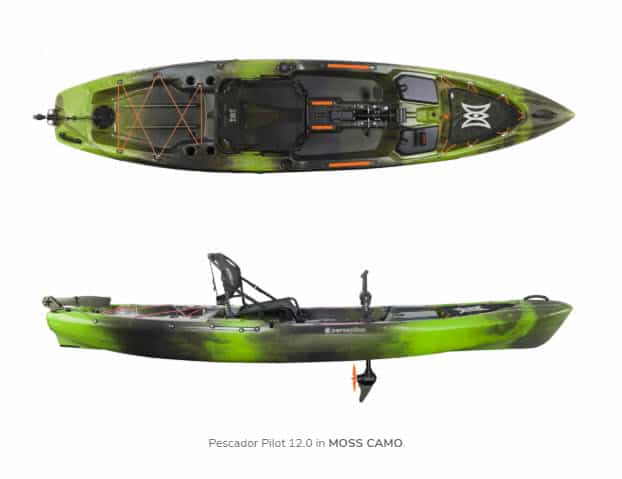
What Are Prop Drive Systems?
Most kayak manufacturers use prop drives. They are less expensive, and the shaft length is usually proportional to the kayak’s overall length. The size of the propeller also varies.
Prop drives are advantageous because they rapidly reverse direction by pedaling quickly in the opposite direction. They’re dependable and often more comfortable for those with a cycling background.
The prop drives have their disadvantages too. These drives are most affected by shallow water when launching, beaching, and pedaling through low-water areas. The drive must be disengaged and pulled out of the water when navigating through weeds. Or you can clear the weeds from the prop and housing while it’s still in the water.
What Is A Mirage Style Drive System?
Mirage drives were first created by Hobie for their line of kayaks. These drives are powered by pedals that you push forward as you would on an elliptical bike at the gym.
Hobie design engineers anticipated that people would want to move through waters with low levels and that there would be a lot of weeds. So they equipped their yaks with fins on the side of the boat. When you pedal forward, the water moves from side to side and raises the boat flush with the hull. This way, you don’t have to clean the weeds as often, and you can avoid hitting sandbars or debris.
These drives require engaging the drive in reverse to pedal backward. And then re-engaging to change direction to forward again.
After the Hobie Mirage patent expired, other companies developed their own versions of the product. Pelican International created the Hydryve to compete in this market.
If you’re on the fence about which type of drive to get for your kayak, watch Beyond The Bounds’ “MUST WATCH Before Buying!! Mirage Drive Vs. Pedal Drives” for a detailed comparison.
Hobie has been working to make the best pedal drives possible. They soon added the mirage 180 with kick-up fins and the mirage drive 360. I go into great detail about the differences between the Hobie Mirage drive 180 and the Miragedrive 360 here.
Hobie does a great job explaining the Miragedrive 360 technology in this video below:
Why Have A Pedal Drive On Your Kayak?
There are different advantages to using a standard or pedal kayak for fishing. It comes down to what you feel most comfortable with and how much you are willing to pay. You need to think about the value of the kayak compared to the cost.
Consider these questions:
- Are you physically healthy and have a strong back?
- Do you get leg cramps often?
- Do you see an advantage of trolling and fishing on the move?
- Would you mind having to disengage and pickup the drive system when needed?
- Would the smaller foot area bother you while standing?
- Are you strong enough to paddle through heavy waters?
- Are you on a tight budget and need a lower cost?
There are a few things you should think about when choosing the type of kayak that’s right for you.
Which Pedal Drive System Is Right For You?
There are many different types of pedal drive systems. Which one is best depends on what you want to use it for.
When choosing a drive system for your kayak, there are many things to contemplate. You will need to consider what is important to you and decide if a pedal drive is better than a standard kayak.
Mirage style drive advantages:
- Noise. Most pedal drives make noise, some with a slight whine. The Mirage drive is much quieter.
- Power. I’ve tried both and feel that the Mirage drive has more power, which could be critical in choppy waters. Additionally, it may provide a slightly higher top speed.
- Storability during transport. The Mirage drives lay flat when disengaged and removed. The pedal drives are like laying a small bicycle on its side in your back seat. So, it takes up more room.
- Fins tuck in against the hull in shallow water and weeds.
Pedal drive advantages:
- Ease while changing direction. Most pedal drives can change direction simply by pedaling forward or backward. For Mirage drives, the user must pull one of two shift cables to pivot the fins 180 degrees, which is more effort to switch direction from forward to reverse and back again.
- Cost. Hobie kayaks are considerably higher in most cases. The newer Mirage 360 drive, while easier to change direction by using a knob, raises the price even higher.
How Much Does A Fishing Kayak With Pedals Cost Vs A Standard (With 2022 Prices)?
Kayaks are priced based on length and whether it has a drive or not.
Here are some comparable pricing options for 2022:
- The Hobie Mirage Outback (12’ 9”) currently costs $3449.
- The Pelican “The Catch 130 Hydryve” (12’ 6”) currently costs $1740 which shows the wide price difference between these two Mirage style drives.
A comparable prop drive kayak would be:
- The Ocean Kayak “Malibu Pedal” (12’ 0”) which currently costs $2300.
- The Old Town “Topwater 120 PDL” (12’ 0”) for $2450. This indicates a real savings over the Hobie but not the Pelican Hydryve.
Comparable standard kayaks without a drive would include:
- The Pelican “The Catch 120″ (11’ 8”) priced at $830.
- The Old Town “Topwater 120 Angler” (12’ 0”) at $1300.
- Hoodoo Stingray 130S Deluxe Fishing Kayak (13’ 0”) at $930.
Summary
So, now that you have all this information, what is your next step?
If you’re excited about a pedal kayak and want to buy one, check out some of the manufacturer links in this article for more information on specific models. Be sure to also read reviews before making your purchase!
And if you decide a pedal kayak isn’t right for you after reading this post, feel free to leave a comment below, letting me know why. I’d love to hear about your experiences in the comments below!

